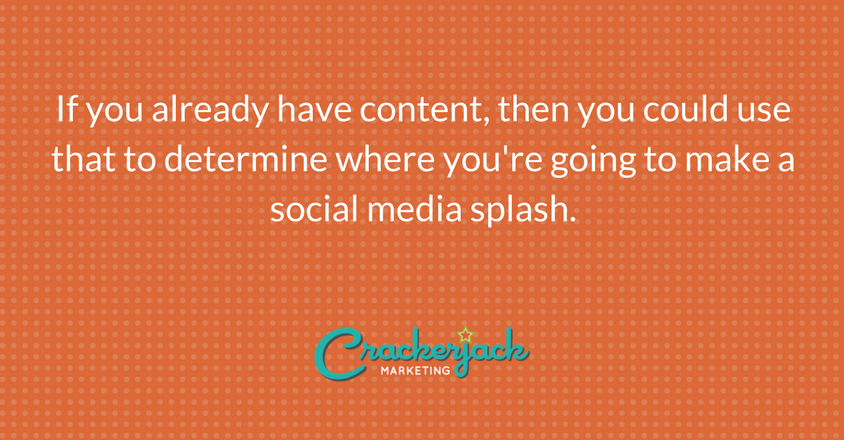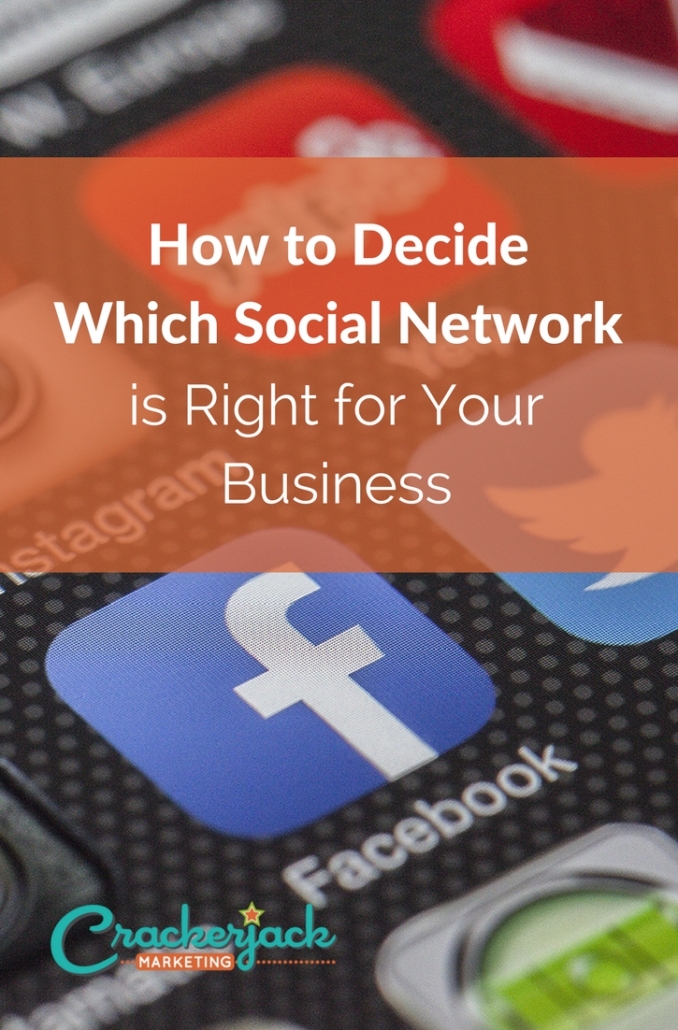How to Decide Which Social Network is Right for Your Business

There are already more social networks than we know what to do with. In addition to those trying to fix social networking, like Ello, there are networks for almost every niche. So how do you pick the ones your business should spend time on.
Let’s be clear: it’s almost impossible to do several social networks well on your own. If you’re a small business without an individual or team dedicated to social media, you’ll find it hard to handle all the social media marketing tasks for every network. Unless you’re planning to hire a marketing agency you have to pick a place to start, whether that’s Twitter, Facebook, Pinterest, Instagram, LinkedIn or another network.
Here are some of the questions to ask to help you make the decision.
1. What does the research tell you?
A good starting point is the demographics of each social media site. If you have a breakdown of the age, gender, education, income and interests for the different sites, you can pick the site or sites where the profile best matches your own customer personas. (Google Analytics includes demographic data in its reporting, so it’s easy to check for similarities.) You can probably guess that if you’re marketing to business, LinkedIn is a good place to start, and if you are trying to attract teens, then Snapchat is a better bet for your marketing focus. Check out research reports like this one from Pew Internet and this recent roundup from Sprout Social to help you decide.
2. Where are your customers?
After doing the research, see if it matches where your customers are. You’re probably already collecting data to help with this. Use analytics software to see where people were before they came to your site or blog, and to check out their path through your site.
Pay particular attention to the social media reports which show which social sites bring the most visitors to you and which social sites most of your visitors use to share your content. Sometimes the data might surprise you. For example, I discovered that people were sharing my content on Stumbleupon even though I didn’t have a button for it.
Add to your knowledge store by using a social media analytics tool to get detailed information on where your customers are. A dashboard aggregator like SumAll or Cyfe will help you to view this data across multiple platforms.
Between them, these should help you narrow down some social media starting points, but there’s another aspect to consider.
3. Where are your competitors?
You already know who your key competitors are, but do you know what they’re doing on social media? If you’re targeting the same customer base, then it’s helpful to know which social media sites they favor, who they are talking to (and who’s talking to them), what kind of engagement they are getting and how you can improve on that with your own social media strategy. Check out Swellpath’s guide to social media competitive analysis to help with this.
4. What kind of content do you have available?
If you already have content, then you could use that to determine where you’re going to make a social media splash. If you’re already creating appealing graphics, then Instagram could be good for you. And if you’re selling products to a mostly female demographic, putting product images on Pinterest is a good strategy. The research you did in steps 1 and 2 will help you match demographics, online presence and content for the best outcome.

Taking a Shortcut
Of course, if you want to take a shortcut and start with a single social media site, then that shortcut has to be Facebook. The Pew Internet research linked earlier shows that 71% of adults are active Facebook users. Sure, it might be difficult to advertise there, but if you want to be social and don’t mind a crowd, it’s a place where you can share videos, images, short updates, long updates, news – almost anything. No matter what you do in creating your social media strategy, you won’t escape the lure of the huge Facebook audience, so consider making that your starting point while you do your research and choose your next social media target.
Which social media site did you create a business presence on first?

She’s been in social media for over 20 years, and teaches digital marketing at universities in Barcelona and Bangkok.
Follow her on LinkedIn
for expert LinkedIn and marketing advice.
STEPHANIE SCHWAB
CEO & Founder
Stephanie is the Founder and CEO of Crackerjack Marketing.
She’s been in social media for over 20 years, and teaches digital marketing at universities in Barcelona and Bangkok.
Follow her on LinkedIn
for expert LinkedIn and marketing advice.
Categories
How to Decide Which Social Network is Right for Your Business

There are already more social networks than we know what to do with. In addition to those trying to fix social networking, like Ello, there are networks for almost every niche. So how do you pick the ones your business should spend time on.
Let’s be clear: it’s almost impossible to do several social networks well on your own. If you’re a small business without an individual or team dedicated to social media, you’ll find it hard to handle all the social media marketing tasks for every network. Unless you’re planning to hire a marketing agency you have to pick a place to start, whether that’s Twitter, Facebook, Pinterest, Instagram, LinkedIn or another network.
Here are some of the questions to ask to help you make the decision.
1. What does the research tell you?
A good starting point is the demographics of each social media site. If you have a breakdown of the age, gender, education, income and interests for the different sites, you can pick the site or sites where the profile best matches your own customer personas. (Google Analytics includes demographic data in its reporting, so it’s easy to check for similarities.) You can probably guess that if you’re marketing to business, LinkedIn is a good place to start, and if you are trying to attract teens, then Snapchat is a better bet for your marketing focus. Check out research reports like this one from Pew Internet and this recent roundup from Sprout Social to help you decide.
2. Where are your customers?
After doing the research, see if it matches where your customers are. You’re probably already collecting data to help with this. Use analytics software to see where people were before they came to your site or blog, and to check out their path through your site.
Pay particular attention to the social media reports which show which social sites bring the most visitors to you and which social sites most of your visitors use to share your content. Sometimes the data might surprise you. For example, I discovered that people were sharing my content on Stumbleupon even though I didn’t have a button for it.
Add to your knowledge store by using a social media analytics tool to get detailed information on where your customers are. A dashboard aggregator like SumAll or Cyfe will help you to view this data across multiple platforms.
Between them, these should help you narrow down some social media starting points, but there’s another aspect to consider.
3. Where are your competitors?
You already know who your key competitors are, but do you know what they’re doing on social media? If you’re targeting the same customer base, then it’s helpful to know which social media sites they favor, who they are talking to (and who’s talking to them), what kind of engagement they are getting and how you can improve on that with your own social media strategy. Check out Swellpath’s guide to social media competitive analysis to help with this.
4. What kind of content do you have available?
If you already have content, then you could use that to determine where you’re going to make a social media splash. If you’re already creating appealing graphics, then Instagram could be good for you. And if you’re selling products to a mostly female demographic, putting product images on Pinterest is a good strategy. The research you did in steps 1 and 2 will help you match demographics, online presence and content for the best outcome.

Taking a Shortcut
Of course, if you want to take a shortcut and start with a single social media site, then that shortcut has to be Facebook. The Pew Internet research linked earlier shows that 71% of adults are active Facebook users. Sure, it might be difficult to advertise there, but if you want to be social and don’t mind a crowd, it’s a place where you can share videos, images, short updates, long updates, news – almost anything. No matter what you do in creating your social media strategy, you won’t escape the lure of the huge Facebook audience, so consider making that your starting point while you do your research and choose your next social media target.
Which social media site did you create a business presence on first?

Search our Blog
Get our Free Editorial Calendar Template.
Are you stressed out by the time it takes to create great content?
In this handy Google Doc, which you can save and use on your own, you’ll get a super-simple layout to guide your content creation and management efforts.
DOWNLOAD TODAY
STEPHANIE SCHWAB
CEO & Founder
Stephanie founder and CEO of Crackerjack Marketing.
She’s been in social media for over 20 years, and teaches digital marketing at universities in Barcelona and Bangkok.
Follow her on LinkedIn
for expert LinkedIn and marketing advice.
Create your own spark
Join 5,000+ marketers who receive our B2B marketing ideas and insights each week.
Join 5,000+ marketers who receive our B2B marketing ideas and insights each week.
Who We Serve
Company
Who We Are
Our Services
Blog
Free Editorial Calendar Template
Work With Us
Resources
Chicago, Barcelona, Mumbai
1055 W. Bryn Mawr Suite F-196
Chicago, IL 60660
+1-312-429-5588
Headquarters:
© Copyright 2025 Kyle Partners, LLC, d/b/a Crackerjack Marketing. All rights reserved. | Terms of Service | Privacy Policy
